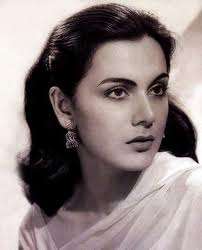Priya Rajvansh
| Priya Rajvanshi | |
|---|---|
 Priya Rajvansh | |
| Born |
Vera Sunder Singh 1937 Simla, Punjab, British India (now Shimla, Himachal Pradesh, India) |
| Died |
27 March 2000 Mumbai, Maharashtra, India |
| Occupation | Actress |
| Years active | 1964–86 |
| Partner(s) | Chetan Anand |
Priya Rajvansh (1937 – 27 March 2000), born Vera Sunder Singh, was an Indian film actress, who is known for her performance in Hindi films like, Heer Raanjha (1970) and Hanste Zakhm (1973), amongst a handful of films she did during her career.
Early life and education
Priya Rajvansh was born as Vera Sunder Singh in Shimla in a Sikh family. Her father Sunder Singh was a Conservator in the Forest Department. She grew up in Shimla along with her brothers, Kamaljit Singh (Gulu) and Padamjit Singh. She studied at Auckland House, where she was school captain, and Convent of Jesus and Mary, Shimla. She passed intermediate from St. Bede's College, Shimla in 1953, and joined Bhargava Municipal College (BMC), during this period, she acted in several English plays at Shimla's noted Gaiety Theatre.
Her father was on a UN assignment, so after graduation she joined the prestigious Royal Academy of Dramatic Art (RADA) in London, UK.[1][2][3]
Career
While still in London and 22 years old, one of her photographs, clicked by a London photographer, somehow reached the Hindi film industry and Chetan Anand, (brother of Dev Anand and Vijay Anand) in 1962, who cast her in his next film, Haqeeqat (1964), which remains one of the most noted war-films in India. Soon she was in a relationship with her mentor, Chetan Anand, who had just separated from his wife; Priya was many years younger and very beautiful and the two grew close to each other. Thereafter she starred only in Chetan Anand's films, where she was involved in every aspect of film-making from story to scripting, lyrics, and post-production. Chetan, too, never made a film without her as the central character. Despite being a highly talented actress, her anglicised accent and western femininity did not click with the Indian audience.
Her next film, Heer Raanjha came out only in 1970, where she acted opposite the rage of that time, actor Raaj Kumar, and the film was a hit. Then came Hanste Zakhm, arguably the finest film of her career, in 1973. Her other noted films were Hindustan Ki Kasam (1973), and Kudrat (1981), where she had a parallel role with Hema Malini in the lead. Her last film Haathon Ki Lakeeren came out in 1985. After that her film career ended and she died in 2000.
Personal life
Priya Rajvansh and Chetan Anand had a personal relationship and they lived together, though she kept her own flat first in Kalumal Estate and, later, a bigger house in Mangal Kiran. Her two brothers, Kamaljit Singh (Gulu) and Padamjit Singh, reside in London and the USA respectively, and have an ancestral home in Chandigarh.[4]
After Chetan Anand's death in 1997, she inherited a part of his property along with his sons from his first marriage. She was murdered on 27 March 2000 in Chetan Anand's Ruia Park bungalow in Juhu, Mumbai, India. Police charged Chetan Anand's sons Ketan Anand and Vivek Anand along with their employees Mala Choudhary and Ashok Chinnaswamy with her murder.[5] Their motive was thought to be rights to her inheritance of Chetan Anand's property. Rajvansh's handwritten notes and a letter addressed by her to Vijay Anand were produced in court as evidence by the prosecution.[6] The letter and notes throw light on Rajvansh's fear and anxiety during the period prior to her death under mysterious circumstances.
The four accused were convicted and sentenced to life imprisonment in July 2002.[7][8][9][10] In 2011, the Mumbai high court accepted the appeals filed by the accused duo against the trial court's order.[11]
Filmography
| Title | Role |
|---|---|
| Haathon Ki Lakeeren (1986) | |
| Kudrat (1981) | Karuna |
| Sahib Bahadur (1977) | |
| Hanste Zakhm (1973) | Chandaa (Devanagari: चन्दा ) |
| Hindustan Ki Kasam (1973) | |
| Heer Raanjha (1970) | Heer |
| Haqeeqat (1964) |
References
- ↑ Feeding on Priya's memories, Gullu lives on... The Tribune, 3 August 2002.
- ↑ Priya Rajvansh, the adored Shimlaite The Tribune, Chandigarh, 21 April 2000.
- ↑ Glamour girls from Himachal Pradesh The Tribune, 16 March 2007.
- ↑ Tribute to Priya Rajvansh The Times of India, Harneet Singh, TNN 2 August 2002.
- ↑ Priya Rajvansh case: Anand brothers get bail The Times of India, PTI, 1 November 2002.
- ↑ "Verdict in Priya murder case". Mid-day.com. Retrieved 2012-04-19.
- ↑ Lifer for 4 in Priya Rajvansh murder case The Times of India, PTI 31 July 2002.
- ↑ Rajvansh killed for property? The Tribune, 6 April 2000.
- ↑ 'It has still to sink in' Rediff.com, 8 April 2000.
- ↑ Anand duo gets life term for Priya's murder The Times of India, 31 July 2002.
- ↑ HC set to hear Anands' plea in Priya Rajvansh murder case The Times of India, 20 January 2011.